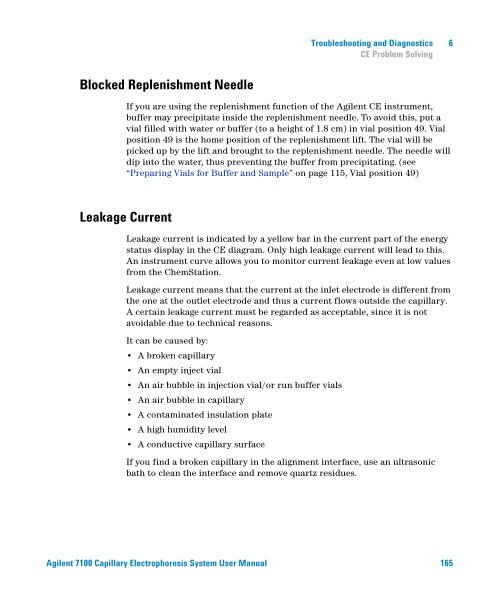Introduction to the Agilent 7100 Capillary Electrophoresis System
Introduction to the Agilent 7100 Capillary Electrophoresis System
Introduction to the Agilent 7100 Capillary Electrophoresis System
Create successful ePaper yourself
Turn your PDF publications into a flip-book with our unique Google optimized e-Paper software.
Troubleshooting and Diagnostics 6<br />
CE Problem Solving<br />
Blocked Replenishment Needle<br />
If you are using <strong>the</strong> replenishment function of <strong>the</strong> <strong>Agilent</strong> CE instrument,<br />
buffer may precipitate inside <strong>the</strong> replenishment needle. To avoid this, put a<br />
vial filled with water or buffer (<strong>to</strong> a height of 1.8 cm) in vial position 49. Vial<br />
position 49 is <strong>the</strong> home position of <strong>the</strong> replenishment lift. The vial will be<br />
picked up by <strong>the</strong> lift and brought <strong>to</strong> <strong>the</strong> replenishment needle. The needle will<br />
dip in<strong>to</strong> <strong>the</strong> water, thus preventing <strong>the</strong> buffer from precipitating. (see<br />
“Preparing Vials for Buffer and Sample” on page 115, Vial position 49)<br />
Leakage Current<br />
Leakage current is indicated by a yellow bar in <strong>the</strong> current part of <strong>the</strong> energy<br />
status display in <strong>the</strong> CE diagram. Only high leakage current will lead <strong>to</strong> this.<br />
An instrument curve allows you <strong>to</strong> moni<strong>to</strong>r current leakage even at low values<br />
from <strong>the</strong> ChemStation.<br />
Leakage current means that <strong>the</strong> current at <strong>the</strong> inlet electrode is different from<br />
<strong>the</strong> one at <strong>the</strong> outlet electrode and thus a current flows outside <strong>the</strong> capillary.<br />
A certain leakage current must be regarded as acceptable, since it is not<br />
avoidable due <strong>to</strong> technical reasons.<br />
It can be caused by:<br />
• A broken capillary<br />
• An empty inject vial<br />
• An air bubble in injection vial/or run buffer vials<br />
• An air bubble in capillary<br />
• A contaminated insulation plate<br />
• A high humidity level<br />
• A conductive capillary surface<br />
If you find a broken capillary in <strong>the</strong> alignment interface, use an ultrasonic<br />
bath <strong>to</strong> clean <strong>the</strong> interface and remove quartz residues.<br />
<strong>Agilent</strong> <strong>7100</strong> <strong>Capillary</strong> <strong>Electrophoresis</strong> <strong>System</strong> User Manual 165
















